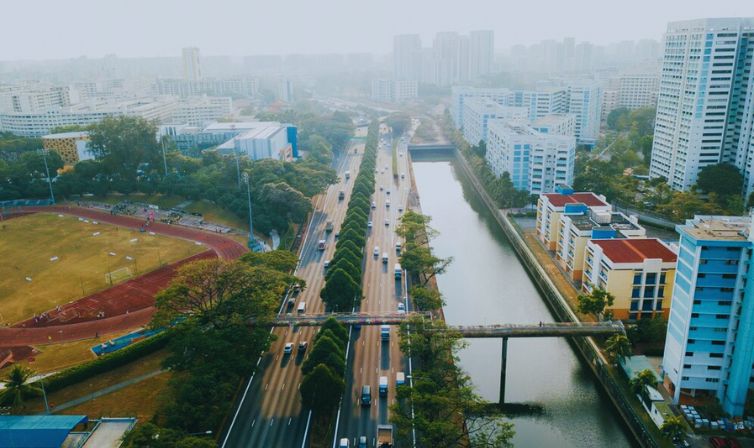Southeast Asia’s Infrastructure Boom: The Importance of Connectivity
24 April 2025
6 Mins Read

- Infrastructure in Southeast Asia: The Overview
- Infrastructure in Southeast Asia Boom: Roads, Factories, And Clean Energy
- Transportation: Faster Roads And Smarter Trains
- Manufacturing: The Factories of Tomorrow
- Energy: Going Green
- How Does Infrastructure In Southeast Asia Contribute To Business Growth?
- What’s Next?
- The Driving Force Behind Southeast Asia’s Transformation
- Wrapping It Up!
Remember those postcard-perfect scenes of Southeast Asia we used to dream about? Rustic streets, sleepy beach towns, and lantern-lit night markets?
Well, I just got back from a trip there after ten years, and let me tell you—it’s like stepping into the future while still holding onto its soul.
Sure, the food is still mind-blowing, but what strikes a returning traveler is how much the region has evolved.
Those once-quaint alleys of Hanoi? Now dotted with sleek cafés serving artisanal coffee over 5 G.
Bali’s rice terraces? Still breathtaking, but now with digital nomads working remotely from jungle co-working spaces.
And Singapore—good lord, it feels like a sci-fi city where even the hawker stalls take digital payments!
The real magic? The infrastructure. High-flex industrial cables powering towering skyscrapers, seamless data connectivity even in remote islands, and metro systems so efficient they put some Western cities to shame.
It’s as if the whole region has hit fast-forward, blending tradition with hyper-modern growth without losing its charm. Ready to learn more? Read on…
Infrastructure in Southeast Asia: The Overview

The real excitement lies in the infrastructure. From sturdy JJ-LAPP cables powering impressive skyscrapers to reliable internet access even in remote islands, the advancements are remarkable.
Metro systems are so efficient that they could give many Western cities a run for their money.
It’s as if the whole region has hit fast forward, merging tradition with modern growth—all while keeping its charm intact.
And the best part? This rapid development is just getting started! The new businesses, startups, and innovative ideas for sustainable tourism are emerging everywhere.
You cannot just call it a visit! It’s a glimpse into a powerful transformation.
Infrastructure in Southeast Asia Boom: Roads, Factories, And Clean Energy
Mega projects are often considered one of the most powerful drivers for economic development, regional development, and societal development.
Even Southeast Asia’s mega infrastructure boom is affecting the roads, factories, and industries as well as the overall clean energy. Read on to know more!
Transportation: Faster Roads And Smarter Trains
One of the most thrilling changes is in transportation. Vietnam is building its first high-speed train line, which will connect Hanoi and Ho Chi Minh City, reducing the travel time from 30 hours to just 8 hours.
Meanwhile, Thailand is expanding its metro system in Bangkok to alleviate the city’s notorious traffic congestion.
Indonesia is making headlines with the Jakarta-Bandung High-Speed Rail, Southeast Asia’s first bullet train, which will connect the two cities in under 45 minutes.
The Philippines is also stepping up its game with a new subway system designed to serve over 500,000 passengers daily.
Manufacturing: The Factories of Tomorrow
Southeast Asia is emerging as a key player in manufacturing, with countries like Thailand, Malaysia, and Vietnam leading the charge.
Thailand’s Eastern Economic Corridor is transforming into a high-tech manufacturing hub, attracting investments in electric vehicles and smart factories.
Vietnam is being called the “new China” for manufacturing, with the country expanding its industrial parks to incorporate advanced production lines for electronics and textiles.
Indonesia is focusing on processing nickel for electric vehicle batteries, aiming to be a major contributor to the green energy movement. It’s an exhilarating time for the region!
Energy: Going Green
Southeast Asia is increasingly turning to clean energy. This is more like a response to climate change.
For example, consider Laos. They are building hydropower Dams. On the other hand, the Philippines is moving towards geothermal energy. Similarly,
- Vietnam is expanding its solar and wind energy capacity,
- Singapore is innovating with floating solar panels.
- Cambodia is launching new solar plants to reduce reliance on coal.
How Does Infrastructure In Southeast Asia Contribute To Business Growth?
Given the current scenario, all of us can agree that Asia is currently undergoing a massive infrastructure boom. And what are the factors that are driving this boom?
It is the rapid economic growth, great urbanization, and the ambition to connect the regions.
Now, we cannot simply say that the transformation is entirely based on the physical structure. The entire landscape represents a great paradigm shift in the way the regions are connected.
As a result, the Infrastructure in Southeast Asia has been playing a crucial role in the ultimate business growth.
It facilitates trades, reduces transportation costs, and further enhances overall competitiveness.
Additionally, major investments in roads, digital infrastructure, and ports are creating a highly favorable environment for businesses.
What’s Next?
Southeast Asia is poised for a smarter, greener, and more connected future, and these projects are making this vision increasingly evident.
The region is poised to emerge as a global leader in the years to come. The reason? Well, the improved transportation is leading to cutting-edge factories and cleaner energy sources.
The key question remains—how fast can Infrastructure in Southeast Asia continue to grow?
The momentum in Southeast Asia’s infrastructure boom shows no signs of slowing, and for good reason—the world’s major economies.
China, the United States, Japan, and the European Union rely heavily on the region for trade, manufacturing, and supply chain stability.
Southeast Asia strengthens its ports, highways, and digital infrastructure. Global businesses are poised to benefit from faster logistics, smarter factories, and more efficient energy grids.
But with so much at stake, cutting corners on quality isn’t just a local risk—it’s a global concern.
The choice is clear: invest in high-performance infrastructure now, or risk disruptions that could ripple across the world’s economy. The future of trade depends on how well Southeast Asia builds today.
The Driving Force Behind Southeast Asia’s Transformation
Southeast Asia is undergoing a remarkable economic transformation, with new skyscrapers rising, factories bustling with activity, and high-speed trains connecting cities like never before.
But what’s fueling this rapid growth? The answer lies in robust connectivity and infrastructure.
Strong connections—both digital and physical—are essential for modern economies.
In manufacturing plants across Vietnam and Thailand, durable cables enable machines to operate smoothly and prevent overheating.
Data centers in Singapore and Malaysia rely on fast internet to handle the high volume of online data.
Even renewable energy projects, like solar farms in Indonesia, require reliable wiring to distribute power efficiently.
Not all growth is good growth. Some businesses, eager to cut costs. They are also seeking alternatives to more expensive, uncertified cables and components.
This can lead to a single weak link, such as a damaged cable or a faulty connection, disrupting entire operations.
For instance, a car manufacturing plant in Thailand experienced significant delays due to faulty sensor cables, resulting in millions of dollars in lost production.
That’s why investing in robust infrastructure is crucial for businesses and governments as they navigate this rapidly evolving environment.
Wrapping It Up!
Southeast Asia’s rise is impressive, but its future depends on strong, reliable infrastructure.
From factory floors to smart cities, every sector needs top-tier connectivity solutions to avoid disruptions.
The message is clear: South East Asia will remain culturally strong and tantalize the world’s tastebuds with its exotic array of cuisine, yet the growth is indispensable and massive.
It is not just a requirement but the only option going forward to move ahead with this growth.
Indonesia’s new capital, Nusantara, is being built as a green, smart city, but its success depends on uninterrupted power and data infrastructure.
If contractors use substandard electrical components, the city could face blackouts or cyber vulnerabilities.
Therefore, the reiteration remains and emphasizes the importance of maintaining standards and quality for both current and future projects.



















Comments Are Closed For This Article